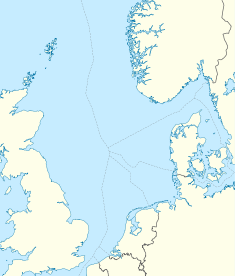Magnus oilfield
| Magnus oilfield | |
|---|---|
| Location of Magnus oilfield | |
| Country | Scotland, United Kingdom |
| Region | North Sea |
| Offshore/onshore | Offshore |
| Coordinates | 61°32′N 1°35′E / 61.533°N 1.583°ECoordinates: 61°32′N 1°35′E / 61.533°N 1.583°E |
| Operator | BP |
| Partners |
BP Marubeni Nippon Eni |
| Field history | |
| Discovery | 1974 |
| Start of production | 1983 |
| Abandonment | 2015 |
| Production | |
| Current production of oil | 15,000-18,000 barrels per day (~−880,000 t/a) |
| Current production of gas | 100×106 cu ft/d (2.8×106 m3/d) |
| Estimated oil in place | 1,540 million barrels (~2.10×108 t) |
The Magnus oilfield is a large oilfield in the United Kingdom's zone of North Sea. It is located 160 kilometres (99 mi) north-east of the Shetland Islands. The field is located mainly in Block 211/12a. Resources are estimated to total 1.54 billion barrels (245×106 m3) of oil, of which 869 million barrels (138.2×106 m3) are recoverable reserves.
The Magnus oilfield was discovered in March 1974 by BP. The discovery was made 2,709 metres (8,888 ft) below the seabed in the younger sands of the Late Jurassic by the semi-submersible drilling rig Sedco 703. Similarly to several other fields in the area, the field was named after the Viking saint–Magnus of Orkney. It was announced on January 24th, 2017 that BP will sell a 25% share of the field and turn over the operatorship to EnQuest.
Fabrication of the Magnus structure began in 1980 at Highland Fabricators' yard at Nigg Bay in the Cromarty Firth. The jacket of the Magnus platform, the main oil export pipeline to the Ninian Central Platform, and the Northern Leg Gas Pipeline to Brent A were installed by 1982. In May 1996, the production started at the South Magnus field. First oil from the field was achieved in August 1983.
The enhanced oil recovery project was proposed in 2000. It was implemented in 2003.
Magnus field's reserves are estimated to contain 1.54 billion barrels (245×106 m3) of oil, of which 869 million barrels (138.2×106 m3) are recoverable reserves.
...
Wikipedia

